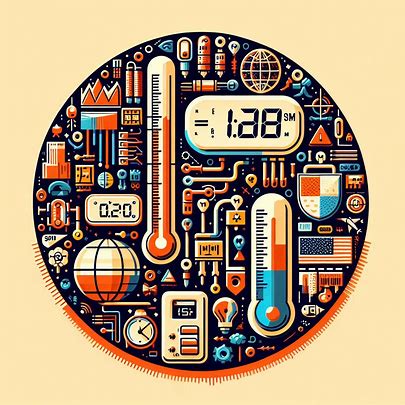Temperature sensors play a critical role in monitoring and controlling temperature across various industries, ensuring the smooth and efficient operation of processes and machinery. As industries continue to evolve with advancements in automation, smart technologies, and IoT, the demand for temperature sensors is rising significantly, especially in North America. This growth is being driven by sectors such as manufacturing, automotive, healthcare, energy, and electronics, where precise temperature control is essential for quality, safety, and efficiency.
https://www.marketsandmarkets.com/pdfdownloadNew.asp?id=522


This article explores the industry-wise growth of temperature sensors in North America, focusing on how different sectors are leveraging these sensors to drive innovation and optimize operations.
1. Automotive Industry: Advancing Efficiency and Safety
In North America’s automotive industry, temperature sensors have become essential for ensuring engine performance, battery management, and emissions control. With the growing demand for electric vehicles (EVs), the role of temperature sensors in battery temperature monitoring has become even more critical.
Key Growth Drivers:
- Electric Vehicles (EVs): As the shift toward EVs accelerates, temperature sensors are critical in managing battery heat during charging and discharging. Thermocouples and thermistors are used to monitor and control the temperature of battery packs, ensuring safety and prolonging battery life.
- Emission Regulations: Stricter emission control regulations are driving the need for advanced temperature sensors that can accurately monitor exhaust gases and control engine temperatures to meet standards set by environmental agencies.
By ensuring efficiency and meeting environmental regulations, temperature sensors in the automotive industry are expected to see steady growth in North America.
2. Manufacturing Industry: Driving Industrial Automation
In the manufacturing sector, temperature sensors play a key role in ensuring that industrial processes run smoothly. From metal fabrication to food processing, precise temperature control is crucial to maintaining product quality and optimizing production.
Key Growth Drivers:
- Industrial Automation: As manufacturing facilities in North America adopt more automated systems, the need for temperature monitoring has increased. Smart factories rely on sensors to collect real-time data that can be analyzed to optimize production processes and reduce energy consumption.
- Quality Control: Temperature sensors are used extensively in process control and quality assurance, ensuring that products meet specifications. For example, in the chemical and pharmaceutical industries, precise temperature control is required for mixing and reaction processes.
The rise of Industry 4.0 is expected to drive further adoption of advanced temperature sensing technologies, such as wireless sensors and IoT-connected devices, in manufacturing.
3. Healthcare Industry: Ensuring Patient Safety and Equipment Functionality
The healthcare industry in North America heavily relies on temperature sensors to maintain the integrity of medical equipment and pharmaceuticals, as well as to monitor patients.
Key Growth Drivers:
- Medical Devices: Temperature sensors are integral to medical devices like MRI machines, incubators, and thermometers, ensuring they operate at optimal temperatures for accurate diagnostics and treatment.
- Pharmaceutical Storage: The rise of biopharmaceuticals and vaccines has increased the need for temperature-controlled storage. Temperature sensors help monitor and maintain the required cold chain during transportation and storage, preventing product spoilage.
- Patient Monitoring: Wearable temperature sensors are becoming more common for remote patient monitoring and telehealth. These sensors can provide real-time data on body temperature, which is critical for patient care in hospitals and home healthcare settings.
With the growing demand for advanced medical technologies and patient safety measures, the healthcare industry in North America is expected to see a significant rise in the use of temperature sensors.

4. Energy and Power Industry: Enhancing Safety and Efficiency
The energy sector, particularly in oil and gas, renewable energy, and power generation, relies on temperature sensors for safety and efficiency.
Key Growth Drivers:
- Oil & Gas: In the oil and gas industry, temperature sensors are used to monitor drilling operations, pipeline safety, and refining processes. High-precision sensors are essential for preventing equipment failure and ensuring compliance with safety standards.
- Renewable Energy: Temperature sensors are becoming increasingly important in renewable energy applications, such as solar power and wind energy. In solar panels, temperature sensors help monitor the efficiency of photovoltaic cells, while in wind turbines, they ensure proper operation of gears and generators.
- Power Plants: In traditional power generation, temperature sensors are critical for monitoring boiler temperatures, turbine efficiency, and cooling systems. The increased adoption of smart grid technologies is also driving demand for sensors to optimize energy distribution.
As the energy sector continues to evolve with green energy initiatives and safety regulations, temperature sensors will play an even greater role in enhancing operational efficiency.
5. Electronics Industry: Ensuring Product Reliability and Innovation
The electronics industry in North America is experiencing rapid growth, driven by demand for consumer electronics, semiconductors, and wearable devices. Temperature sensors are critical in these areas to ensure that devices function properly and do not overheat.
Key Growth Drivers:
- Semiconductor Manufacturing: The semiconductor industry relies heavily on temperature sensors for controlling processes like etching, doping, and cleaning during chip production. Precise temperature management is essential for ensuring the integrity and performance of microchips.
- Consumer Electronics: In devices like smartphones, tablets, and laptops, temperature sensors help prevent overheating and extend the lifespan of components. They are also key in managing battery temperatures in devices.
- Wearable Technology: The growing trend in wearable health devices and smartwatches is boosting the demand for small, precise temperature sensors that can monitor skin temperature and detect environmental changes.
The ongoing innovation in electronics and the increasing complexity of consumer devices ensure a continuous demand for temperature sensors in this sector.
Conclusion: A Bright Future for Temperature Sensors in North America
Temperature sensors are increasingly becoming an integral part of industrial processes in North America, enabling businesses to optimize operations, maintain product quality, and ensure safety. Across industries like automotive, manufacturing, healthcare, energy, and electronics, the demand for precise temperature monitoring and control is growing rapidly.
As these industries adopt smart technologies, IoT, and automation, the role of temperature sensors will only expand. The North American market is poised to see significant growth in the deployment of temperature sensing solutions, with industries leveraging these technologies to enhance efficiency, reduce operational costs, and meet regulatory requirements.
The future of temperature sensors in North America is bright, driven by technological advancements and the increasing need for precision in various industrial applications.
